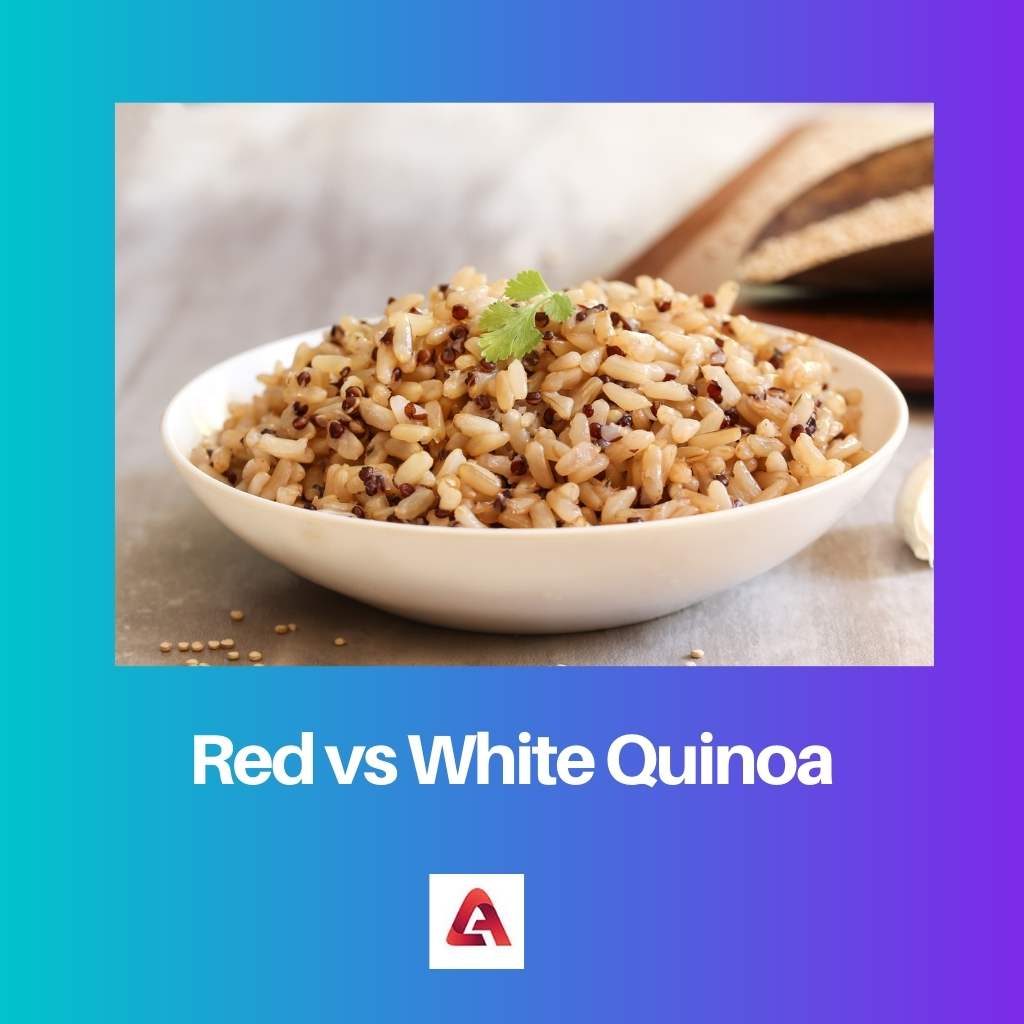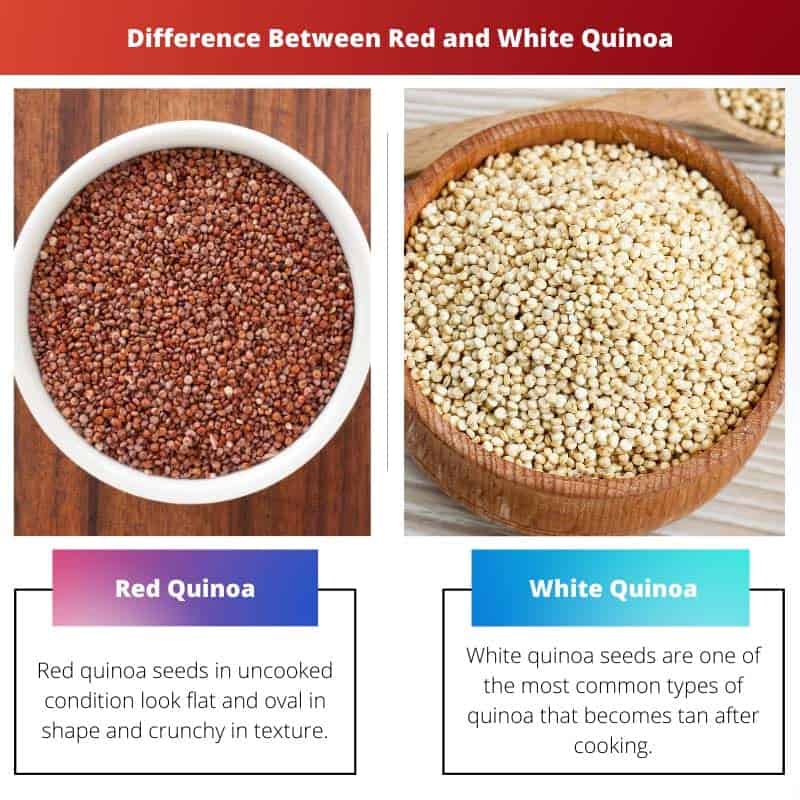Quinoa is one of the healthiest foods on the planet, providing twice as much protein as white rice. Red, white, and black quinoa are the three most common types of quinoa.
They are seeds obtained from a plant called Chenopodium quinoa which is native to South America.
The Spanish people started replacing it with cereals, but today it is one of the first choices for a gluten-free healthy diet that is rich in carbohydrates, protein, and antioxidants.
Key Takeaways
- Red quinoa has a nuttier flavor and a firmer texture than white quinoa.
- White quinoa cooks faster and has a softer, more delicate texture than red.
- Red quinoa retains its shape better after cooking, making it ideal for salads and cold dishes.
Red vs White Quinoa
Red and white quinoa differ in their texture, taste, appearance, and nutritional values. While red quinoa is much crunchy and retains its shape while cooking, white quinoa has a delicate taste and a light texture that does not tend to dominate over other ingredients in a food item.

Red quinoa seeds in uncooked condition look flat and oval in shape and crunchy in texture. They became fluffy after cooking but not as much as white quinoa and became chewier.
Red quinoa seeds are gluten-free and yet contain the nutritional values of whole grain.
White quinoa seeds are one of the most common types of quinoa that becomes tan after cooking. Several other names are given to white quinoa, such as golden quinoa, ivory quinoa, etc.
They are less crunchy in texture and become puffier after cooking. They also require less cooking time and are perfect for a quick meal during the weekdays.
Comparison Table
| Parameters of Comparison | Red Quinoa | White Quinoa |
|---|---|---|
| History | Red Quinoa is native to South America where the native soldiers (Inca soldiers) believed that the red color gave them strength during the war. | White Quinoa has become a popular source of nutrition for the last 5,000 years, especially in Peru and Bolivia. |
| Texture | Uncooked red quinoa is very crunchy and on cooking turns chewier. | White quinoa has the lightest texture among all types of quinoa. |
| Taste | Red quinoa has a very rich taste. | White quinoa has a very light and delicate taste and doesn’t overpower the taste of other ingredients. |
| Color | Red quinoa turns a bit brownish after cooking. | White quinoa is available more in a tan shade rather than pure white. |
| Cooking | Red quinoa takes more time to cook. | White quinoa can be prepared more quickly. |
| Nutritional Value | Red quinoa contains more fibers and carbohydrates. | White quinoa contains more calories and fats. |
| Micronutrients | Red quinoa contains a comparatively low amount of micronutrients. | White quinoa contains comparatively more iron and phosphorus. |
| Health Benefits | Red quinoa reduces the chances of heart diseases. | White quinoa helps in improving blood sugar and cholesterol levels. |
| Recipes | Red quinoa is more suitable for cold salad recipes because it can retain its shape during cooking. | White quinoa gets fluffier after cooking so they are appropriate for dishes like porridge and casseroles. |
What is Red Quinoa?
Red quinoa has a great deal of nutritional value and health benefits. One cup of cooked red quinoa (185 grams) contains 222 calories, 40 grams of carbohydrates, 5 grams of fibre, and 8 grams of protein.
It also contains a good amount of manganese and copper. Each serving also provides sufficient vitamin B6 for proper metabolism and brain functioning.
Red quinoa’s taste is very overpowering and tends to dominate in a dish. It is crunchy in uncooked condition and, upon cooking, becomes chewier.
Since they can retain their texture even after cooking, they are mostly used in a quinoa salad. It becomes brownish after cooking.
Though quinoa seeds are rich in flavonoids, red quinoa is exclusively rich in kaempferol and quercetin.
The former helps to reduce the risk of chronic illnesses and heart diseases, whereas the latter helps to protect the body against Parkinson’s disease, osteoporosis, etc.

What is White Quinoa?
White quinoa, also famous as ivory or golden quinoa, is the lightest of all the quinoa seeds. They have a very delicate texture and taste that doesn’t dominate other ingredients in a particular dish.
When cooked, white quinoa becomes tan in color and they also become much fluffier as compared to red quinoa.
The fat content of white quinoa is more than that of red quinoa. White quinoa also contains a rich amount of micronutrients, especially iron, phosphorus, and riboflavin.
It helps in maintaining a decent blood sugar level, thus reducing the chances of heart and kidney disease.
White quinoa also takes comparatively less time to prepare. Because of its fluffier texture, white quinoa is more appropriate for preparing cooked dishes like porridge.

Main Differences Between Red and White Quinoa
- Red quinoa was very famous among the Inca soldiers as the Inca Red as they believed the color was a sign of strength in the battles. But, the white-coloured quinoa doesn’t have much history behind its color.
- Uncooked red quinoa is very crunchy and, on cooking, turns chewier, whereas white quinoa has the lightest texture among all types of quinoa.
- Red quinoa has a very overpowering and rich taste, whereas white quinoa has a delicate taste that doesn’t overpower the taste of other ingredients in a dish.
- Red quinoa becomes brownish after cooking, whereas white quinoa comes in a shade of tan than pure white.
- Red quinoa takes more time to cook as compared to white quinoa.
- While red quinoa is rich in fibre and carbohydrates, white quinoa contains a good amount of calories and fats.
- Red quinoa contains a little less micronutrients (iron and phosphorus) than white quinoa.
- Due to its capability to retain the texture, red quinoa is more appropriate for a cold salad, whereas white quinoa is a better option for porridge and smoothies.

- https://www.sciencedirect.com/science/article/pii/S0963996920305998
- https://www.hindawi.com/journals/jchem/2019/7125169/

Who knew there was so much to learn about quinoa! This was surprisingly interesting.
This article did a great job of outlining the nutritional value and benefits of both red and white quinoa, very informative!
Quinoa is certainly a very interesting cereal, it is not so common to find such high nutritional value in these types of common foods.
The information provided is incredibly useful, I will definitely consider including more red and white quinoa in my diet.
The discussion about the differences between red and white quinoa was a bit technical and could have been made simpler for the average reader.
I’ve never been much of a food enthusiast, but this article has provided a clear explanation and comparison between red and white quinoa.